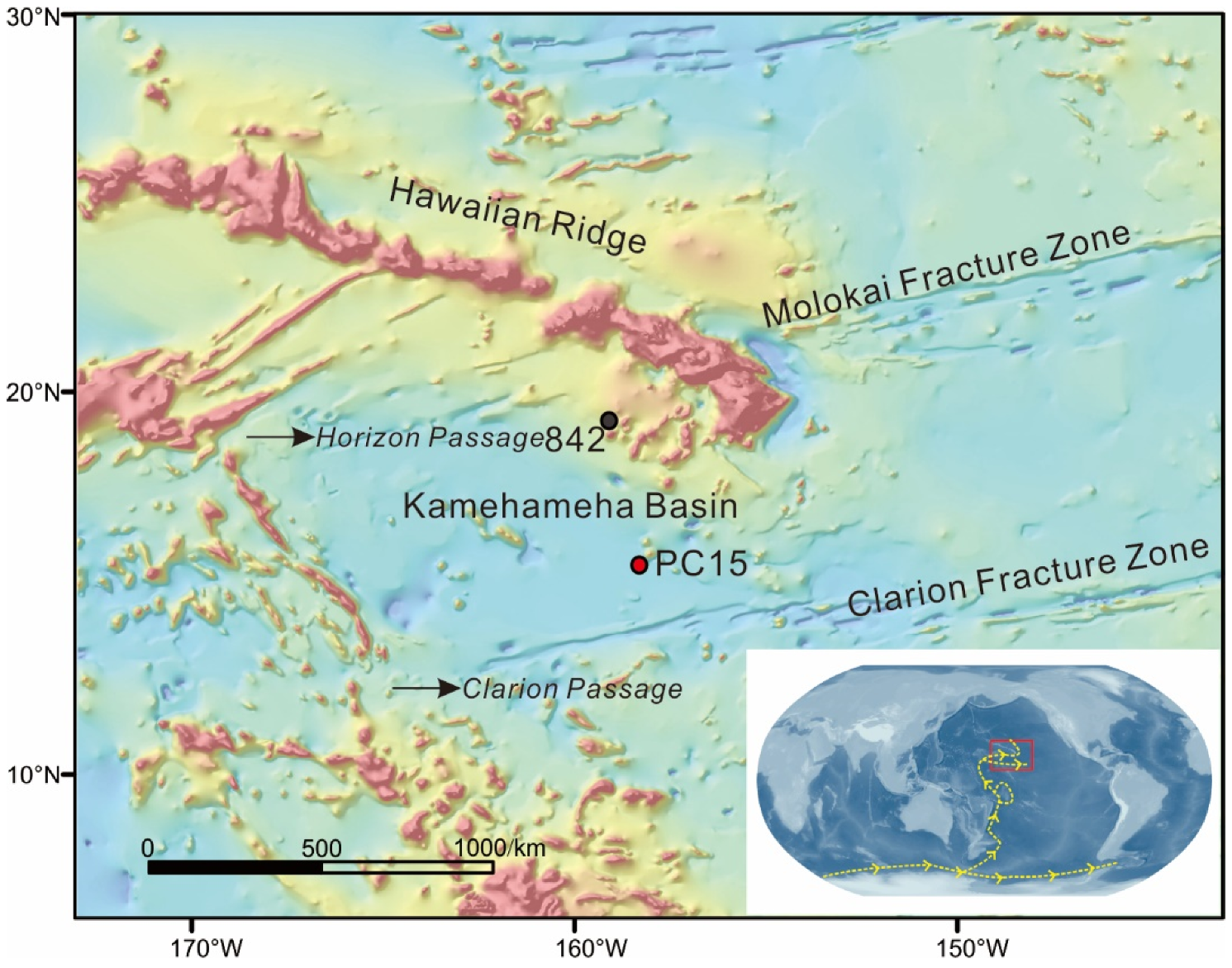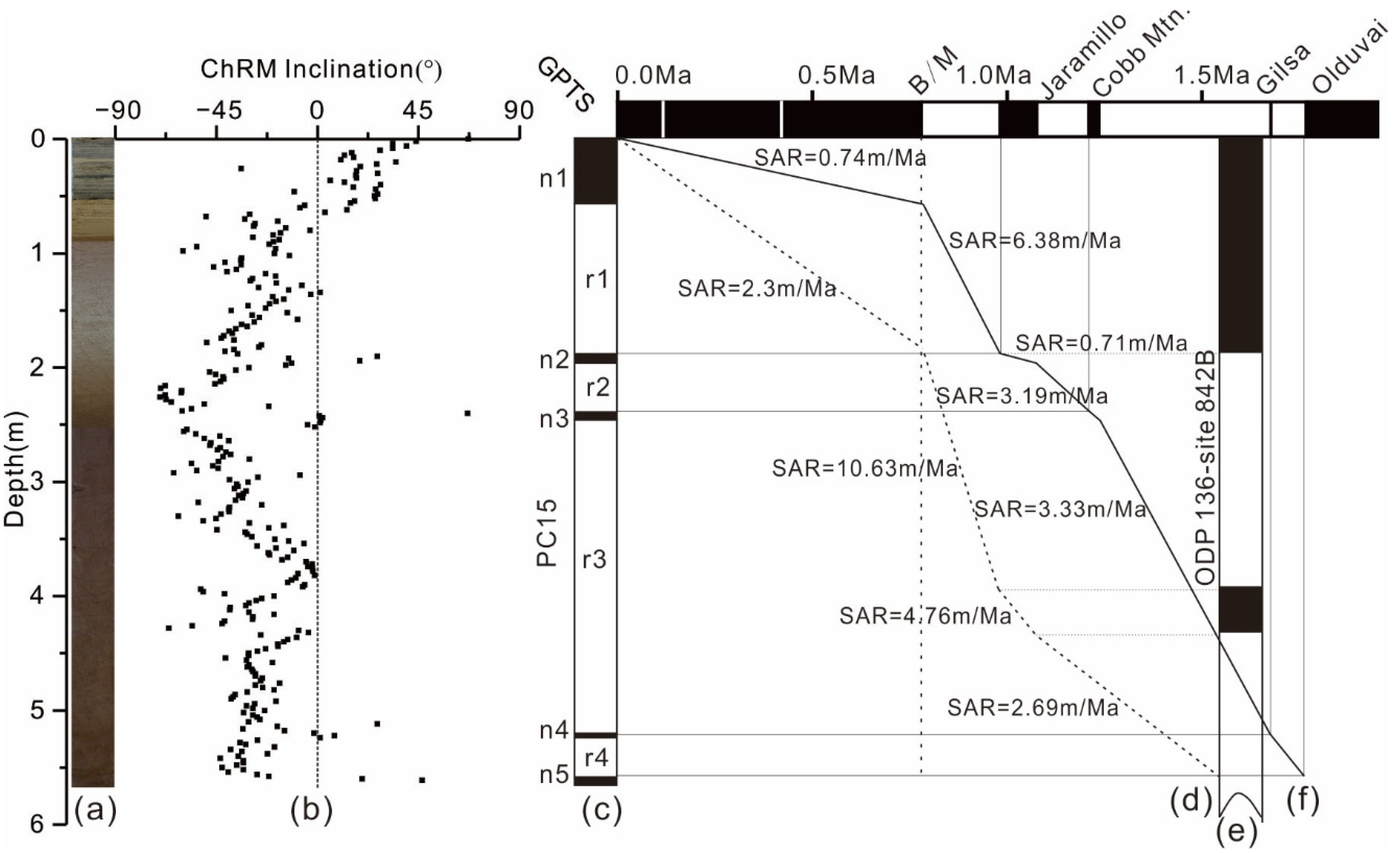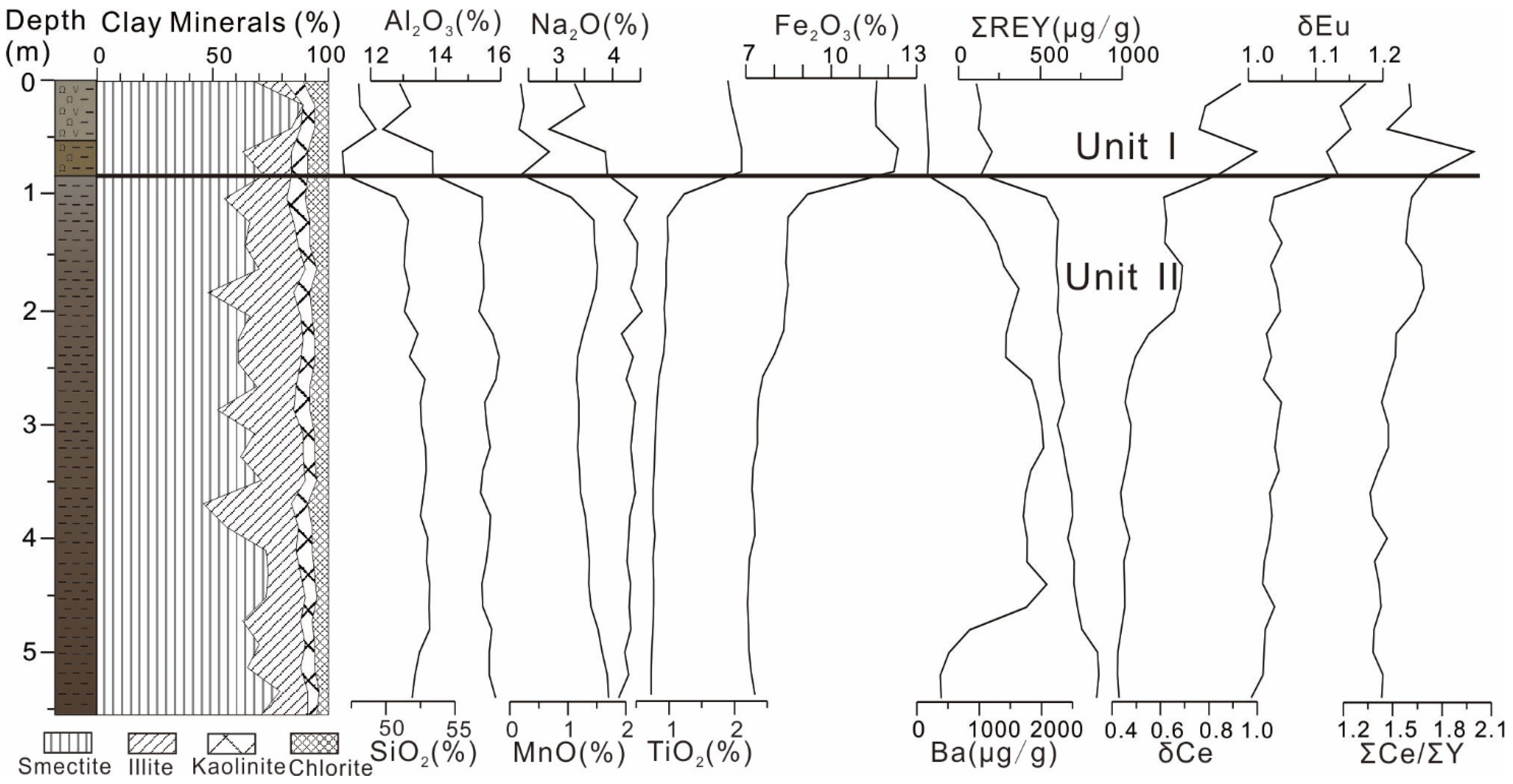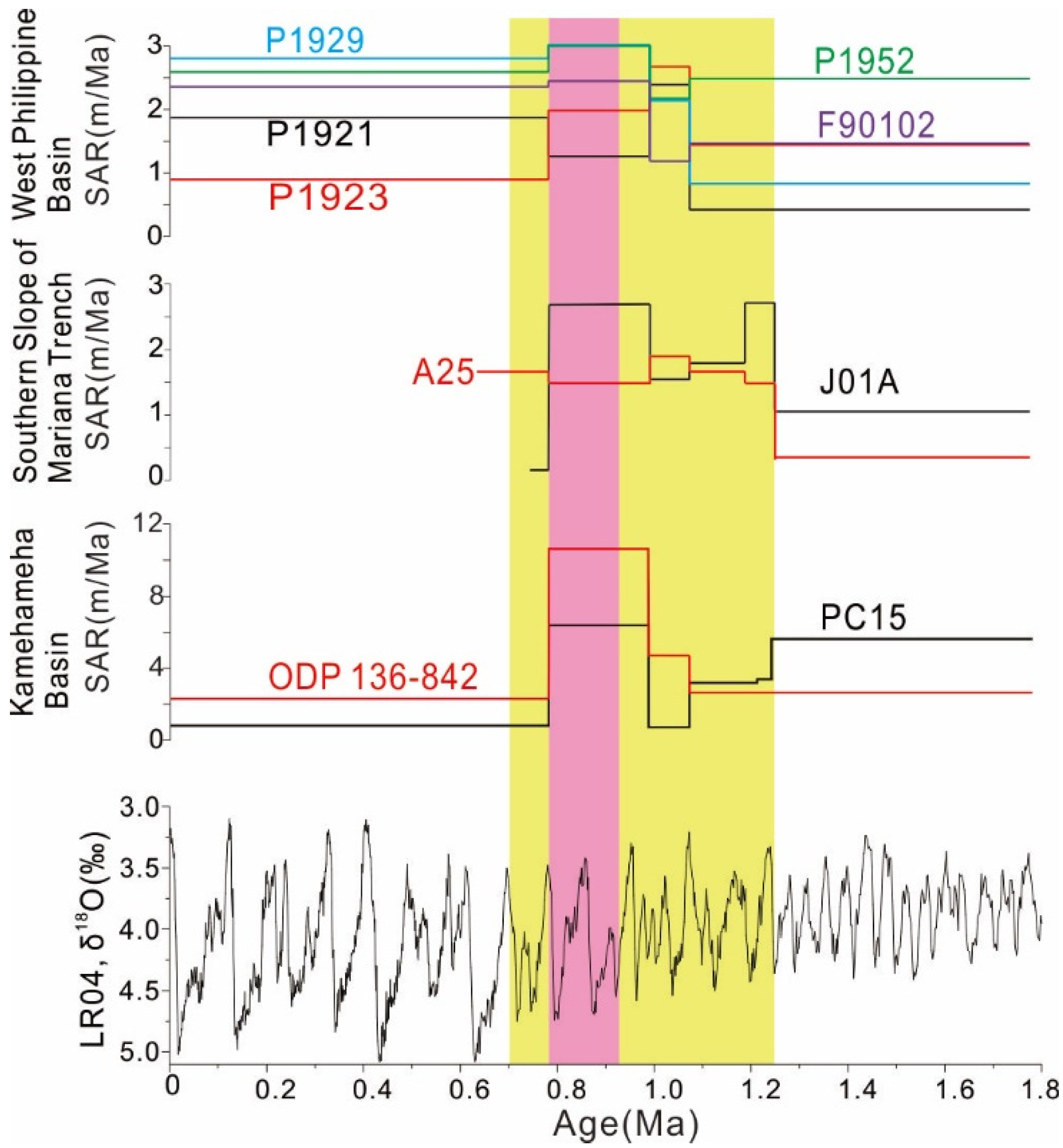Geochemical and Mineral Properties of Quaternary Deep-Sea Sediments in the Central-Tropical Pacific and Its Response to the Mid-Pleistocene Transition
Abstract
:1. Introduction
2. Materials and Methods
2.1. The Studied Core
2.2. Demagnetization
2.3. Clay Minerals Analysis
2.4. Element Analysis
3. Results
3.1. Magnetostratigraphic Results
3.2. Clay Mineral Changes
3.3. Geochemical Properties
4. Discussion
4.1. Sedimentary Changes during the MPT
4.2. Bottom-Water Evolution
5. Conclusions
Supplementary Materials
Author Contributions
Funding
Institutional Review Board Statement
Informed Consent Statement
Data Availability Statement
Acknowledgments
Conflicts of Interest
References
- Clark, P.U.; Archer, D.W.; Pollard, D.; Blum, J.D.; Rial, J.A.; Brovkin, V.; Mix, A.C.; Pisias, N.G.; Roy, M. The middle Pleistocene transition: Characteristics, mechanisms, and implications for long-term changes in atmospheric pCO2. Quat. Sci. Rev. 2006, 25, 3150–3184. [Google Scholar] [CrossRef] [Green Version]
- Korff, L.; von Dobeneck, T.; Frederichs, T.; Kasten, S.; Kuhn, G.; Gersonde, R.; Diekmann, B. Cyclic magnetite dissolution in Pleistocene sediments of the abyssal northwest Pacific Ocean: Evidence for glacial oxygen depletion and carbon trapping. Paleoceanography 2016, 31, 600–624. [Google Scholar] [CrossRef] [Green Version]
- Lear, C.H.; Billups, K.; Rickaby, R.E.; Diester-Haass, L.; Mawbey, E.M.; Sosdian, S.M. Breathing more deeply: Deep ocean carbon storage during the mid-Pleistocene climate transition. Geology 2016, 44, 1035–1038. [Google Scholar] [CrossRef] [Green Version]
- Shi, F.; Yin, Q.; Nikolova, I.; Berger, A.; Ramstein, G.; Guo, Z. Impacts of extremely asymmetrical polar ice sheets on the East Asian summer monsoon during the MIS-13 interglacial. Quat. Sci. Rev. 2020, 230, 106164. [Google Scholar] [CrossRef]
- Lisiecki, L.E.; Raymo, M.E. A Pliocene-Pleistocene stack of 57 globally distributed benthic δ18O records. Paleoceanography 2005, 20, PA103. [Google Scholar] [CrossRef] [Green Version]
- Jansen, E.; Fronval, T.; Rack, F.; Channell, J.E.T. Pliocene-Pleistocene ice rafting history and cyclicity in the Nordic Seas during the last 3.5 Myr. Paleoceanography 2000, 15, 709–721. [Google Scholar] [CrossRef]
- Ruddiman, W.F.; E Raymo, M.; Martinson, D.G.; Clement, B.; Backman, J. Pleistocene evolution: Northern hemisphere ice sheets and North Atlantic Ocean. Paleoceanography 1989, 4, 353–412. [Google Scholar] [CrossRef]
- Schefuß, E.; Damsté, J.S.S.; Jansen, J.H.F. Forcing of tropical Atlantic sea surface temperatures during the mid-Pleistocene transition. Paleoceanography 2004, 19, PA4029. [Google Scholar] [CrossRef] [Green Version]
- Hu, B.; Yi, L.; Zhao, J.; Guo, W.; Ding, X.; Wang, F.; Chen, W. Magnetostratigraphy of core XT06 and quaternary sedimentary dynamics of the deep-sea deposits in the West Philippian Basin. Mar. Geol. Quat. Geol. 2021, 41, 61–74. [Google Scholar] [CrossRef]
- Kawabe, M.; Fujio, S. Pacific ocean circulation based on observation. J. Oceanogr. 2010, 66, 389–403. [Google Scholar] [CrossRef]
- Shimono, T.; Yamazaki, T. Environmental rock-magnetism of Cenozoic red clay in the South Pacific Gyre. Geochem. Geophys. Geosystems 2016, 17, 1296–1311. [Google Scholar] [CrossRef] [Green Version]
- Dziewonski, A.; Wilkens, R.; Firth, J.; Baker, D.J.; Briden, J.C.; Carson, B.; Collins, J.A.; De Carlo, E.H.; Duennebier, F.K.; Dürbaum, H.J.; et al. Site 842. In Proceedings of the Ocean Drilling Program; Winkler, W., Ed.; Initial Reports, 136; Texas A&M University: College Station, TX, USA, 1992; pp. 37–63. [Google Scholar]
- Yi, L.; Xu, D.; Jiang, X.; Ma, X.; Ge, Q.; Deng, X.; Wang, H.; Deng, C. Magnetostratigraphy and Authigenic 10 Be/9 Be Dating of Plio-Pleistocene Abyssal Surficial Sediments on the Southern Slope of Mariana Trench and Sedimentary Processes During the Mid-Pleistocene Transition. J. Geophys. Res. Ocean. 2020, 125, e2020JC016250. [Google Scholar] [CrossRef]
- Smith, W.H.F.; Sandwell, D.T. Global seafloor topography from satellite altimetry and ship depth soundings. Science 1997, 277, 1957–1962. Available online: https://topex.ucsd.edu/WWW_html/mar_topo.html (accessed on 1 November 2021). [CrossRef] [Green Version]
- Chunhui, X.; Yonghong, W.; Jiwei, T.; Xuchen, W.; Yu, X. Mineral composition and geochemical characteristics of sinking particles in the Challenger Deep, Mariana Trench: Implications for provenance and sedimentary environment. Deep. Sea Res. Part I Oceanogr. Res. Pap. 2019, 157, 103211. [Google Scholar] [CrossRef]
- Lyle, M.; Wilson, P. Leg 199 synthesis: Evolution of the equatorial Pacific in the early Cenozoic. In Proceedings of the Ocean Drilling Program, Scientific Results; Wilson, P.A., Lyle, M., Firth, J.V., Eds.; Texas A&M University: College Station, TX, USA, 2006; pp. 1–39. [Google Scholar]
- Kirschvink, J.L. The least-squares line and plane and the analysis of palaeomagnetic data. Geophys. J. Int. 1980, 62, 699–718. [Google Scholar] [CrossRef]
- Lurcock, P.; Wilson, G.S. PuffinPlot: A versatile, user-friendly program for paleomagnetic analysis. Geochem. Geophys. Geosystems 2012, 13, Q06Z45. [Google Scholar] [CrossRef] [Green Version]
- Zhao, S.; Cai, F.; Liu, Z.; Cao, C.; Qi, H. Disturbed climate changes preserved in terrigenous sediments associated with anthropagenic activities during the last century in the Taiwan Strait, East Asia. Mar. Geol. 2021, 437, 106499. [Google Scholar] [CrossRef]
- Biscaye, P.E. Mineralogy and sedimentation of recent deep sea clay in the Atlantic Ocean and adjacent seas and oceans. Geol. Soc. Am. Bull. 1965, 76, 803–832. [Google Scholar] [CrossRef]
- Hilgen, F.J.; Lourens, L.J.; Van Dam, J.A. The Neogene Period, The Geological Time Scale; BV Elsevier Press: Cambridge, MA, USA, 2012; pp. 923–978. [Google Scholar]
- Channell, J.; Singer, B.; Jicha, B. Timing of Quaternary geomagnetic reversals and excursions in volcanic and sedimentary archives. Quat. Sci. Rev. 2020, 228, 106114. [Google Scholar] [CrossRef]
- Chamley, H. Clay Sedimentology; Springer: Berlin, Germany, 1989; pp. 259–289. [Google Scholar]
- Huang, J.; Wan, S.; Zhang, G.; Xu, Z.; Liu, H.; Dong, J.; Li, A.; Li, T. Impact of seafloor topography on distribution of clay minerals in the east Philippines Sea. Mar. Geol. Quat. Geol. 2017, 37, 77–85. [Google Scholar] [CrossRef]
- Ding, X.; Hu, B.; Xu, F.; Guo, J.; Cui, R.; Yi, L. Evolution of clay minerals assemblages since Late Pliocene and its paleoenvironmental implications: Evidence from Core XT4 of the Philippine Sea Basin. Mar. Geol. Quat. Geol. 2020, 41, 42–51. [Google Scholar] [CrossRef]
- Zhang, D. Clay Mineral composition and distribution in the Mariana Trough. J. Oceanogr. Huanghai Bohai Seas 1994, 12, 32–39. [Google Scholar]
- Liu, Z.; Zhao, Y.; Colin, C.; Siringan, F.P.; Wu, Q. Chemical weathering in Luzon, Philippines from clay mineralogy and major-element geochemistry of river sediments. Appl. Geochem. 2009, 24, 2195–2205. [Google Scholar] [CrossRef]
- Yasukawa, K.; Ohta, J.; Miyazaki, T.; Vaglarov, B.S.; Chang, Q.; Ueki, K.; Toyama, C.; Kimura, J.; Tanaka, E.; Nakamura, K.; et al. Statistic and Isotopic Characterization of Deep-Sea Sediments in the Western North Pacific Ocean: Implications for Genesis of the Sediment Extremely Enriched in Rare Earth Elements. Geochem. Geophys. Geosyst. 2019, 20, 3402–3430. [Google Scholar] [CrossRef] [Green Version]
- Wang, F.; He, G.; Lai, P. Nd isotopes of the pelagic sediments and clay fractions from the Pacific Ocean and their provenance significance. Geotecton. Metallog. 2019, 43, 292–301. [Google Scholar] [CrossRef]
- Haskin, A.M.; Haskin, A.L. Rare earths in European shales: A redetermination. Science 1966, 154, 507–509. [Google Scholar] [CrossRef]
- Yao, H.; Wang, F.; Wang, H.; Yu, M.; Ren, J.; He, G.; Chen, W.; Yi, L. Pleistocene magnetostratigraphy of four cores in the West Philippian Basin and regional sedimentary shift during the Mid-Pleistocene transition. Geol. J. 2021, 56, 2919–2929. [Google Scholar] [CrossRef]
- Meng, Q.; Li, A.; Jiang, F.; Xu, Z. A geomagnetic paleointensity record over the last 2 Ma from the east Philippine Sea. Oceanol. Limnol. Sin. 2010, 41, 606–613. [Google Scholar] [CrossRef]
- McClymont, E.L.; Rossel-Mele, A. Links between the onset of modern Walker circulation and the mid- Pleistocene climate transition. Geology 2005, 33, 386–392. [Google Scholar] [CrossRef]
- Sun, Y.; Clemens, S.C.; An, Z.; Yu, Z. Astronomical timescale and paleoclimatic implication of stacked 3.6–Myr monsoon records from Chinese Loess Plateau. Quat. Sci. Rev. 2006, 25, 33–48. [Google Scholar] [CrossRef]
- Dwyer, G.S.; Cronin, T.M.; Baker, P.A.; Raymo, M.E.; Buzas, J.S.; Correge, T. North Atlantic deepwater temperature change during late Pliocene and late Quaternary climatic cycles. Science 1995, 270, 1347–1351. [Google Scholar] [CrossRef] [Green Version]
- Clark, P.U.; Pollard, D. Origin of the Middle Pleistocene transition by ice sheet erosion of regolith. Paleoceanography 1998, 13, 1–9. [Google Scholar] [CrossRef] [Green Version]
- Ziegler, C.L.; Murray, R.W.; Plank, T.; Hemming, R.S. Source of Fe to the equatorial Pacific Ocean from the Holocene to Miocene. Earth Planet. Sci. Lett. 2008, 270, 258–270. [Google Scholar] [CrossRef]
- Goldberg, E.D. Chemical and Mineralogical aspects of deep-sea sediments. Phys. Chem. Earth 1961, 4, 281–302. [Google Scholar] [CrossRef]
- Elderfield, H.; Greaves, M.J. The rare earth elements in seawater. Nature 1982, 296, 214–219. [Google Scholar] [CrossRef]
- Dymond, J.; Suess, E.; Lyle, M. Barium in deep-sea sediment: A geochemical proxy for paleoproductivity. Paleoceanography 1992, 7, 163–181. [Google Scholar] [CrossRef] [Green Version]
- Griffith, E.M.; Paytan, A. Barite in the ocean–occurrence, geochemistry and palaeoceanographic applications. Sedimentology 2012, 59, 1817–1835. [Google Scholar] [CrossRef]
- Paytan, A.; Kasten, M.; Chavez, F.P. Glacial to interglacial fluctuations in productivity in the equatorial Pacific as indicated by marine barite. Science 1996, 277, 1355–1357. [Google Scholar] [CrossRef]
- Guichard, F.; Church, T.M.; Treuil, M.; Jaffrezic, H. Rare earths in barites: Distribution and effects on aqueous partitioning. Geochim. Cosmochim. Acta 1979, 43, 983–997. [Google Scholar] [CrossRef]
- Hodell, D.A.; Venz-Curtis, K.A. Late Neogene history of deepwater ventilation in the Southern Ocean. Geochem. Geophys. Geosystems 2006, 7, Q09001. [Google Scholar] [CrossRef]
- Mix, A.C.; Pisias, N.G.; Rugh, W.; JWilson Morey, A.; Hagelberg, T.K. Benthic foraminifer stable isotope record from site 849 (0–5 Ma): Local and global climate changes. In Proceedings of the Ocean Drilling Program, 138 Scientific Results; Stewart, S.K., Ed.; Texas A&M University: College Station, TX, USA, 1995; pp. 371–412. [Google Scholar]
- Venz, K.A.; Hodell, D.A. New evidence for changes in Plio- Pleistocene deep water circulation from Southern Ocean ODP Leg 177 Site 1090. Palaeogeogr. Palaeoclimatol. Palaeoecol. 2002, 182, 197–220. [Google Scholar] [CrossRef]









| Geomagnetic Polarity Time Scale | Age [21] (Ma) | PC15 Depth (m) | PC15 SARs (m/Ma) | 842 [22] Depth (m) | 842 [22] SARs (m/Ma) |
|---|---|---|---|---|---|
| Surface | 0 | 0 | - | 0 | - |
| C1n (bottom) | 0.781 | 0.58 | 0.74 | 1.8 | 2.3 |
| C1r.1n (top) | 0.988 | 1.9 | 6.38 | 4 | 10.63 |
| C1r.1n (bottom) | 1.072 | 1.96 | 0.71 | 4.4 | 4.76 |
| Cobb Mountain (top) | 1.21 | 2.4 | 3.19 | - | - |
| Cobb Mountain (bottom) | 1.24 | 2.5 | 3.33 | - | - |
| C2n(top) | 1.778 | 5.6 | 5.76 | 6.3 | 2.69 |
Publisher’s Note: MDPI stays neutral with regard to jurisdictional claims in published maps and institutional affiliations. |
© 2021 by the authors. Licensee MDPI, Basel, Switzerland. This article is an open access article distributed under the terms and conditions of the Creative Commons Attribution (CC BY) license (https://creativecommons.org/licenses/by/4.0/).
Share and Cite
Wang, H.; Yi, L.; Deng, X.; He, G. Geochemical and Mineral Properties of Quaternary Deep-Sea Sediments in the Central-Tropical Pacific and Its Response to the Mid-Pleistocene Transition. J. Mar. Sci. Eng. 2021, 9, 1254. https://doi.org/10.3390/jmse9111254
Wang H, Yi L, Deng X, He G. Geochemical and Mineral Properties of Quaternary Deep-Sea Sediments in the Central-Tropical Pacific and Its Response to the Mid-Pleistocene Transition. Journal of Marine Science and Engineering. 2021; 9(11):1254. https://doi.org/10.3390/jmse9111254
Chicago/Turabian StyleWang, Haifeng, Liang Yi, Xiguang Deng, and Gaowen He. 2021. "Geochemical and Mineral Properties of Quaternary Deep-Sea Sediments in the Central-Tropical Pacific and Its Response to the Mid-Pleistocene Transition" Journal of Marine Science and Engineering 9, no. 11: 1254. https://doi.org/10.3390/jmse9111254
APA StyleWang, H., Yi, L., Deng, X., & He, G. (2021). Geochemical and Mineral Properties of Quaternary Deep-Sea Sediments in the Central-Tropical Pacific and Its Response to the Mid-Pleistocene Transition. Journal of Marine Science and Engineering, 9(11), 1254. https://doi.org/10.3390/jmse9111254







